Top 5 Python Frameworks In 2023
Python has rapidly risen as one of the most widely used programming languages. In recent years thanks to its adaptability, ease of learning, and extensive range of applications. One of the key reasons for its popularity is the robust and flexible frameworks that Python offers. This blog will discuss the top Python frameworks and their importance in web development.
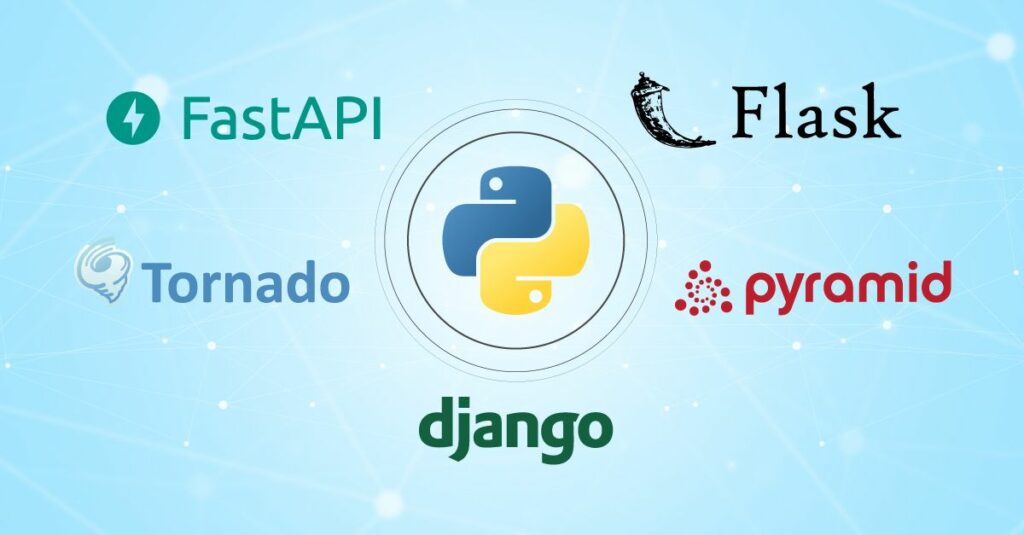
The Importance of Python Frameworks in Web Development
Python frameworks provide developers with a strong base for building web applications quickly and efficiently. They provide ready-to-use modules and tools. These tools enable developers to concentrate on adding distinctive features to their applications instead of spending time on repetitive coding.
Python web frameworks have several benefits, including:
Better Security: It offers improved security with built-in features. These features include password hashing, CSRF protection, and XSS protection, which enhance the security of web applications. Additionally, these frameworks streamline development and accelerate the process. They enable developers to prioritize the creation of high-quality web applications.
Increased Scalability: It is highly scalable, making it easy to expand and modify applications as per business requirements.
Improved Stability: It provides a standard structure and coding style, reducing errors and bugs and improving the stability of applications.
Using a Python framework has several advantages. One of them is that it makes it easier for teams to work together on larger projects. This is due to the standardized method for developing websites that frameworks offer.
Types of Python Frameworks
Python’s popularity has resulted in the emergence of several frameworks. These frameworks make it easier for developers to create web applications quickly and efficiently. This blog will explore the different types of frameworks in Python.
Full-stack frameworks
A full-stack framework encompasses all the necessary components for web development. Moreover, it gives developers everything they need to build a web application from scratch. Additionally, it provides routing, database support, templating, and authentication as some of its features. When it comes to Python frameworks, the most popular ones are Django, Pyramid, and Flask.
Microframeworks
Micro-frameworks, which exclusively provide the essential functionality for web development, offer a minimalist approach to creating tiny to medium-sized online applications. Two well-known Python microframeworks, namely Bottle and Flask, exemplify this concept.
Asynchronous frameworks
Asynchronous frameworks cater to applications requiring non-blocking I/O and high performance. They provide a scalable method for web development by enabling the handling of several requests at once. Asynchronous frameworks are also better able to manage massive amounts of data than other frameworks. Tornado and FastAPI are two well-known Python asynchronous frameworks.
Here is the list of popular Python frameworks and their pros and cons.
1. Django
Django is the most popular Python web framework intended to speed up and simplify web development. It offers extensive features and tools that enable developers to create web apps quickly and effectively. Django, however, has advantages and limitations just like any other technology.
Pros and cons of using Django
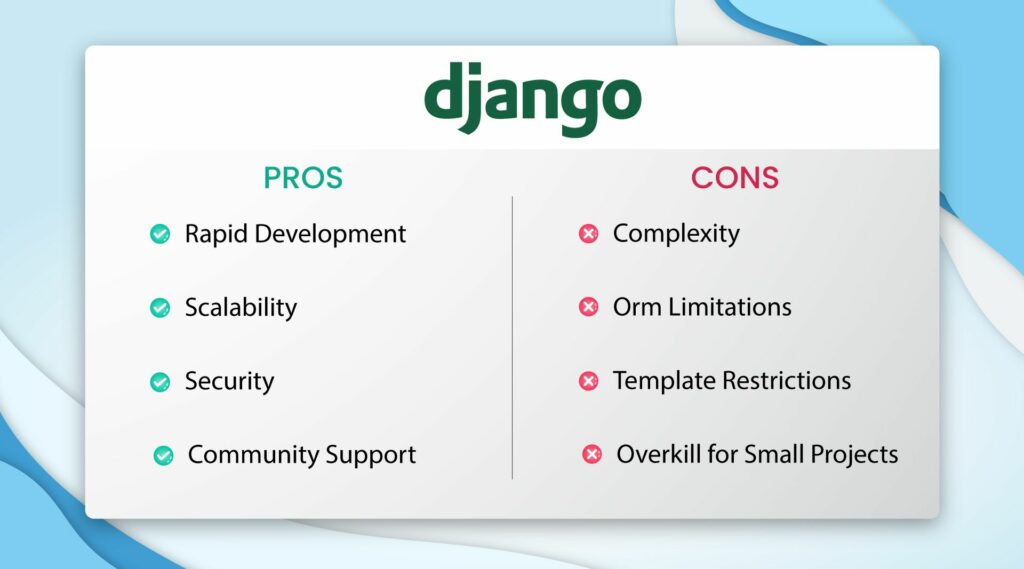
Pros of Django:
Rapid development: Because Django offers many pre-built modules and functionality, developers can write code without starting from scratch. As a result, development time is sped up, and developers are free to concentrate on the unique aspects of their program.
Scalability: Django can manage high volumes of traffic and data since it is meant to be scalable. It is perfect for creating high-traffic apps since it supports load balancing and caching.
Security: Django incorporates numerous built-in security measures to safeguard web applications. It includes robust defenses against common web vulnerabilities like cross-site scripting (XSS) and SQL injection attacks. These security features enhance the overall protection of Django-powered websites. It also has user authentication and authorization tools, making it simple to protect web applications.
Community Support: The Django framework is supported by a sizable and vibrant community of developers providing plugins, modules, and support. If you face any issue, there is a high chance that someone already faces an issue.
Cons of Django:
Complexity: Django has a steep learning curve, making it difficult for newcomers to comprehend the framework’s components and structure. The framework may require some time for developers to understand and master.
ORM limitations: Django’s Object-Relational Mapping (ORM) mechanism has significant restrictions that may not be suitable for all applications. It might not offer the performance and flexibility required for complex database queries.
Template restrictions: The customization and versatility of Django’s templating mechanism can be limited. For developers to create more complex functionality, third-party libraries may be required.
Overkill for small projects: Django’s robustness may be overkill for modest projects that only need some of the framework’s features. A micro-framework like Flask might be a better choice in certain circumstances.
2. Flask
Flask is a second top Python framework. It is the most popular web development framework for developing Python applications, be it small to medium-sized applications. Its popularity is the comprehensive functionality it provides for web development. However, Flask has advantages and disadvantages, much like any other technology.
Pros and cons of using Flask
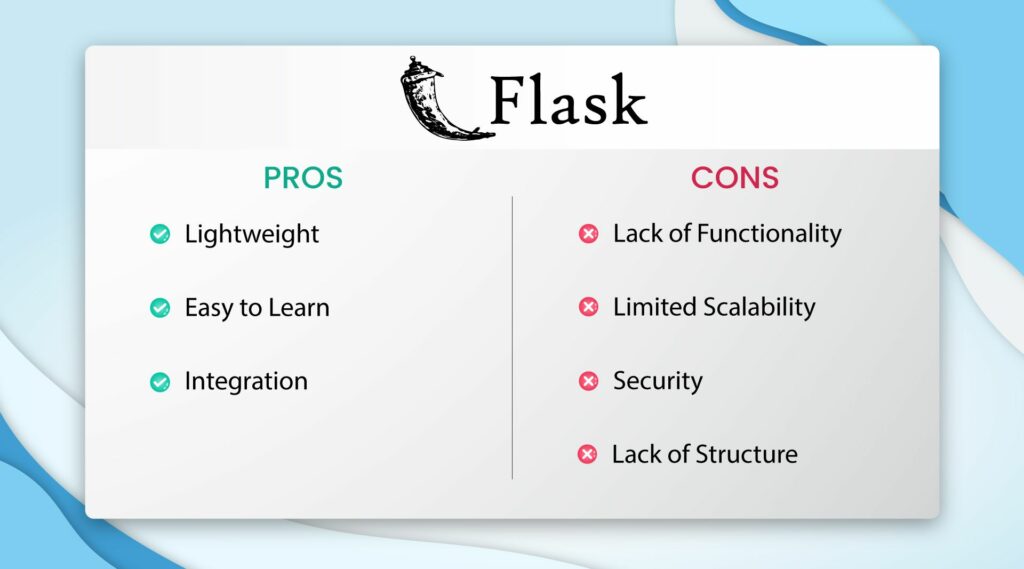
Pros of Flask
Lightweight: Because Flask is a micro-framework, it is small and has few dependencies. Because of this, even novice users may easily set it up and operate it.
Flexibility: Flask is incredibly adaptable and flexible, enabling developers to add features and functionality as required. Because it doesn’t impose any specific project structure or database schema, developers have more freedom to use their methods.
Easy to learn: Flask is more straightforward than other Python web development frameworks like Django, which have a steeper learning curve. Because of this, it’s an excellent option for developers new to web development or who need to launch a project rapidly.
Integration: Integration makes it simple to add functionality to Flask because it connects well with other Python libraries and tools. Additionally, Flask can be used by developers to create a variety of applications, including APIs, web services, and microservices.
Cons of Flask:
Lack of functionality: Flask, as a microframework, only offers the features required for web development. Adding extra functionality may require developers to rely on third-party libraries or plugins, which can take time.
Limited scalability: Flask is limited because it was not created to manage large-scale applications with high traffic or intricate requirements. It might not be the most incredible option for creating complicated, large-scale applications.
Security: Flask, as a framework, lacks built-in security capabilities. It does not provide inherent defenses against common web vulnerabilities such as cross-site scripting (XSS) and SQL injection attacks. Consequently, Flask developers must implement additional security measures to protect their web applications. Developers themselves must implement security measures.
Lack of structure: Flask’s lack of structure has benefits and drawbacks. While it promotes flexibility, it can also result in disorganized code and make managing big projects challenging.
3. Pyramid
Pyramid, a well-liked web framework used in Python, is known for its straightforwardness and adaptability. Moreover, it enables developers to create sophisticated web apps quickly while maintaining simplicity. However, like many technologies, Pyramids come with both advantages and disadvantages.
Pros and cons of using Pyramid
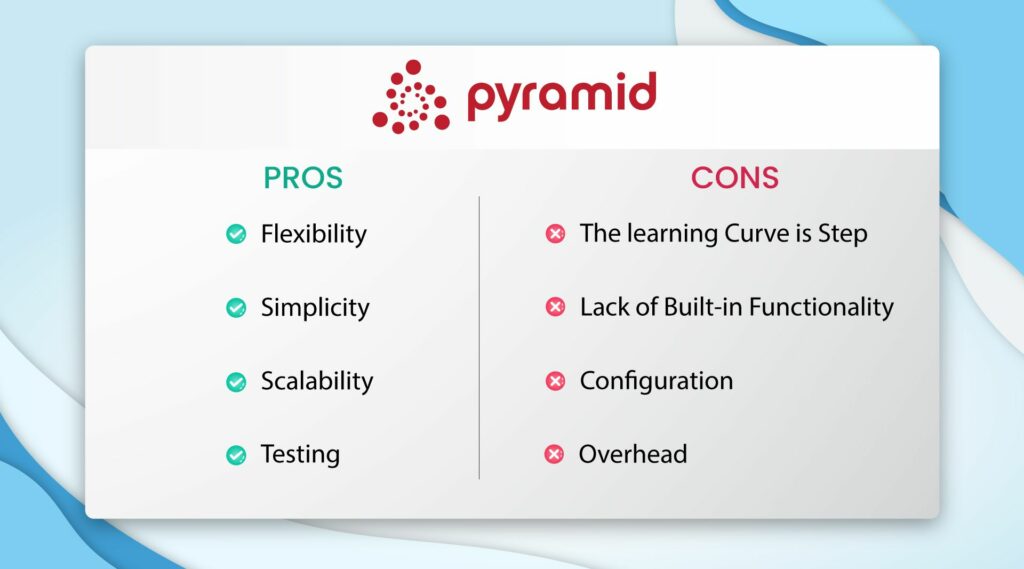
Pros of Pyramid:
Flexibility: Because Pyramid is so adaptable and versatile, developers can add features and functionality as they see fit. Because it doesn’t impose any specific project structure or database schema, developers have more freedom to use their methods.
Simplicity: The Pyramid is intended to be straightforward to use. It is a popular choice among developers new to web development. One of the main reasons is its low learning curve, making it easier for beginners to grasp.
Scalability: The Pyramid was designed with scalability as a priority. It excels in handling large-scale systems with high traffic and complex requirements. This makes it the perfect option for creating sophisticated, large-scale online applications.
Testing: Pyramid has integrated testing tools that simplify testing web applications and ensure they function as intended.
Cons of Pyramid:
The learning curve is steep: Pyramid is known for its straightforward approach. However, it has a steeper learning curve than leading top Python frameworks. Despite this, investing time in mastering Pyramid can lead to a deeper understanding and proficiency in web development. Starting can be more challenging for developers who are new to web development as a result.
Lack of built-in functionality: Authentication and authorization are only two examples of the few built-in functions that Pyramid offers. To add these functionalities, developers might rely on third-party libraries or plugins.
Configuration: Pyramid primarily relies on configuration files, which can be complicated and challenging to manage for big projects.
Overhead: Pyramid can be slower and less effective for some applications since it uses more resources than competing frameworks for Python.
4. FastAPI
FastAPI is one of the Python most popular web frameworks for creating Python APIs. It is one of the cutting-edge frameworks in Python used for creating Python APIs. It is made to be quick, simple to use, and incredibly scalable. FastAPI offers benefits and drawbacks, just like any other technology.
Pros and cons of using FastAPI
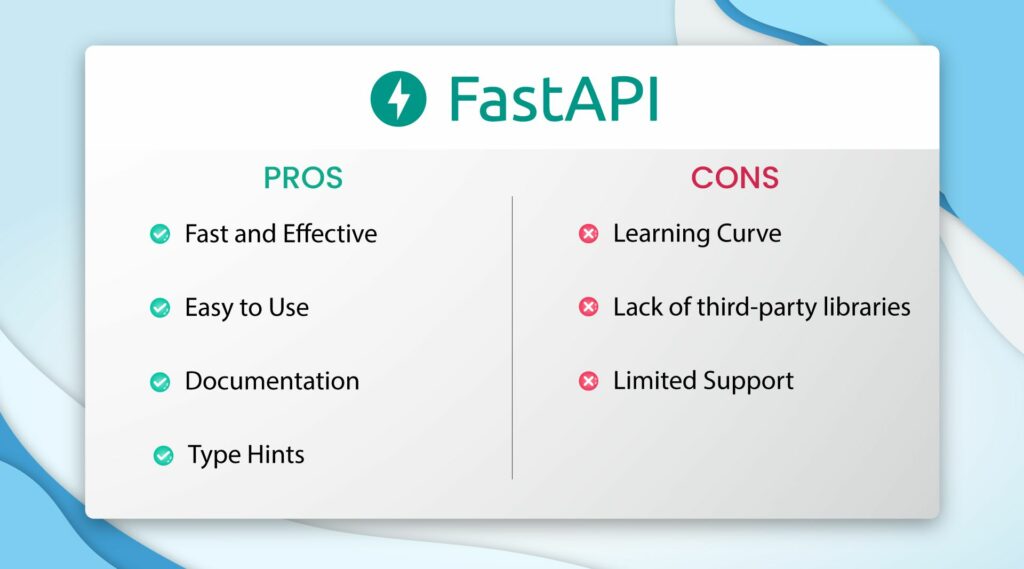
Pros of FastAPI:
Fast and effective: True to its name, FastAPI is quick and effective. It is perfect for developing high-performance APIs since it employs asynchronous programming and has built-in async support.
Easy to use: FastAPI is made simple and has a simple syntax, making it simple to construct APIs quickly.
Documentation: FastAPI generates API documentation automatically, which can help developers save time and effort.
Type Hints: FastAPI includes type hints, aiding early error detection and better code quality.
Cons of FastAPI:
Learning Curve: FastAPI has a steep learning curve. This steep learning curve can make it more challenging for those just starting web development. The advanced concepts and techniques employed by FastAPI may require additional effort and time to grasp for beginners.
Lack of third-party libraries: FastAPI is a relatively new framework. As a result, it may have fewer third-party libraries than more established frameworks.
Limited Support: FastAPI is currently in its early phases of development. As a result, it may need more support compared to more well-established web frameworks.
5. Tornado
For creating high-performance online applications that need real-time updates. Tornado is a Python web application framework. It is a popular choice for developing applications that require real-time updates and persistent connections.
This includes chat applications, stock tickers, and other programs that rely on real-time data feeds. The framework’s capabilities in handling and managing real-time communication make it an attractive option for such applications. Like any technology, Tornado has advantages and disadvantages.
Pros and cons of using Tornado

Pros of Tornado:
High Performance: One of the quickest Python web frameworks on the market, Tornado is built for outstanding performance. Its non-blocking I/O capabilities make it the best choice for developing applications that need real-time updates.
Scalability: Tornado is scalable and capable of managing numerous connections and requests simultaneously.
Easy to Use: Tornado is simple enough for those just starting in web development to use and learn.
Cons of Tornado:
Steep learning curve: Tornado has a steep learning curve. This can pose a challenge for developers who are new to web development.
Limited functionality: Tornado only offers rudimentary capabilities and can need third-party libraries to implement more complex ones.
Poor documentation: Compared to other web frameworks, Tornado’s documentation might be challenging to explore and not as thorough.
Bonus Python Frameworks
Along with the well-known Best Python framework like Django, Flask, Pyramid, and FastAPI, several more frameworks are interesting to investigate. Here are a few of the more well-liked ones:
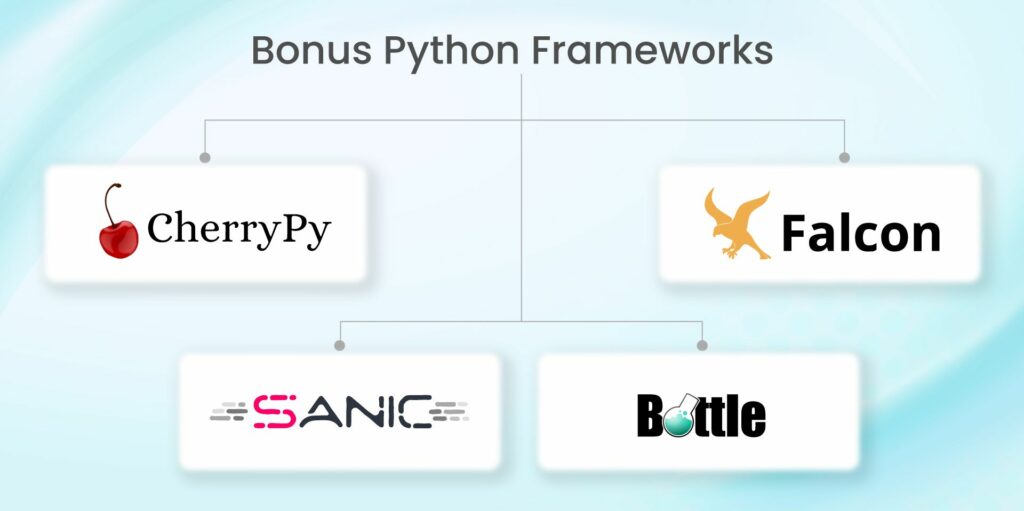
CherryPy:
This simple Python framework creates web services and apps. It is a fantastic choice for small to medium-sized projects. This is because of its straightforward syntax and a great degree of customizability.
Falcon
This compact framework is intended for the creation of RESTful APIs. It is a beautiful option for developing scalable web services because of its quick performance and simplicity.
Sanic
This asynchronous framework is made for producing web apps that load quickly. It is a strong choice for developing real-time apps because of its quick performance and support for asyncio.
Bottle
Bottle is a microframework for creating compact web apps. It is suitable for small to medium-sized applications because it has a straightforward syntax and few dependencies.
Conclusion
Best Python frameworks are essential for web development. They provide developers with pre-built modules and tools. Which helps the development process, speeds up development time, improves stability and scalability, and enhances security.
Different types of Python frameworks exist, including full-stack, micro, and asynchronous. Django is a high-level framework that offers extensive features. On the other hand, Flask is a lightweight micro-framework that provides flexibility and easy integration. Both frameworks have pros and cons and are suitable for different projects.
Choosing the Right Python Framework for your project
When choosing the proper Python framework, there are several factors to consider. These include project specifications, developer experience, availability of third-party libraries, support and documentation, and potential for future expansion. Django is great for web applications, while Tornado is ideal for real-time applications.
Frameworks like Flask and FastAPI are easier to learn, while others like Pyramid require more experience. Think about the quality and accessibility of third-party libraries and the framework’s support and documentation. Finally, consider the framework’s capacity for future expansion, with Pyramid being highly adaptable for complicated projects.
Unlock the potential of your projects with Thinkitive’s Python development services. Empower your software solutions by hiring vetted Python developers through our free trial, and witness the remarkable transformation of your ideas into reality. Hire Python Developers today.




